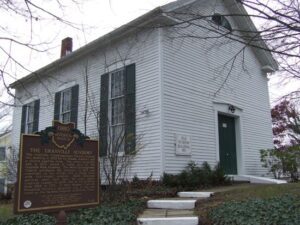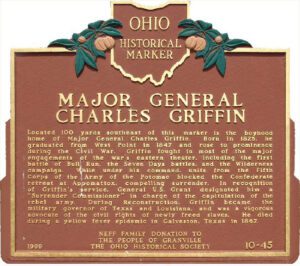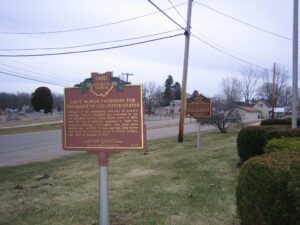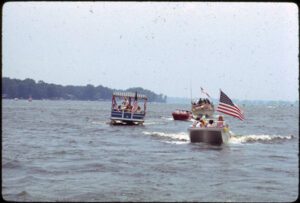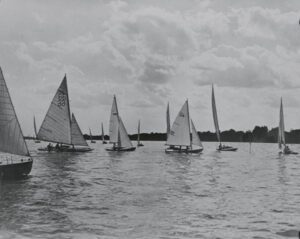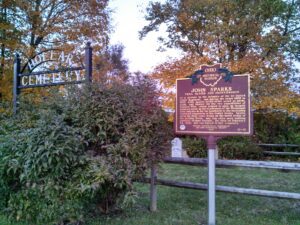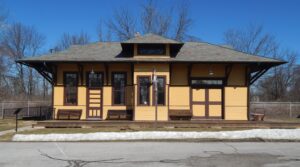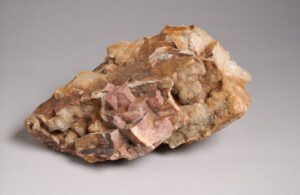, OH
The Granville Congregational Church erected this building in 1833 for its Female Academy and a church meeting room. The school prospered and, in 1837, moved to make way for the Granville Male Academy. The Welsh Congregational Church purchased the structure in 1863 and converted its two stories into a single room with full-height windows. Welsh language services were held here for sixty years. Granville Grange #2230 met in the building from 1923 to 1973. It then became Granville Historical Society’s property and, in 1981, was listed on the National Register of Historic Places.
, OH
Located 100 yards southeast of this marker is the boyhood home of Major General Charles Griffin. Born in 1825, he graduated from West Point in 1847 and rose to prominence during the Civil War. Griffin fought in most of the major engagements of the war’s eastern theater, including the first battle of Bull Run, the Seven Days battles, and the Wilderness campaign. While under his command, units from the Fifth Corps of the Army of the Potomac blocked the Confederate retreat at Appomattox, compelling surrender. In recognition of Griffin’s service, General U.S. Grant designated him a “Surrender Commissioner” in charge of the capitulation of the rebel army. During Reconstruction, Griffin became the military governor of Texas and Louisiana, and was a vigorous advocate of the civil rights of newly freed slaves. He died during a yellow fever epidemic in Galveston, Texas in 1867.
, OH
Soldier, engineer, and statesman, W.S. Rosecrans was born in Delaware County in 1819 and grew up in Homer. He graduated from West Point in 1842. During the Civil War, Rosecrans commanded the federal Army of the Cumberland. Popular with his troops, who called him “Old Rosy,” he was a cautious commander and, though victorious at, Corinth, Murfreesboro, and Chattanooga, he suffered major defeat at Chickamauga in 1863. A skilled engineer, Rosecrans developed coal properties in western (now West) Virginia before the war and helped design St. Joseph’s Cathedral in Columbus for his brother, Bishop Sylvester Rosecrans. Following the war he served as minister to Mexico and represented California in Congress from 1881 to 1885. He died in 1898 and is interred at Arlington National Cemetery.
, OH
Using a four-mile long dam, the state of Ohio impounded the Licking Summit Reservoir in the mid-1820s to supply water for the Ohio and Erie Canal. In 1894, the state renamed it Buckeye Lake and developed it for recreational use. The Columbus, Buckeye Lake, and Newark Traction Company developed an “electric park” here, bringing in excursionists on interurban cars between 1904 and 1929 and creating one of the region’s most popular resorts. Hotels and summer cottages proliferated on leased ground. Nine acres in size, the park featured daily free admission during the summer. (continued on other side)
, OH
Formed by the retreating glacier more than 14,000 years ago, Buckeye Lake first existed as a shallow, swampy pond, named “Buffalo Swamp” by Ohio Company explorer Christopher Gist in 1751. Beginning in 1826 the State developed it as a water source for the Licking Summit of the Ohio and Erie Canal, it being the highest level between the Scioto and Licking rivers. Engineers dammed the north and west sides of the swamp, inadvertently creating a unique floating sphagnum-heath bog surrounded by water. Cranberry Bog, with boreal vegetation typical of glacial-era Ohio, is a registered National Natural Landmark. (continued on other side)
, OH
As a private in the infantry of the 1st United States Regiment, and during the years 1805 to 1807, John Sparks (1758-1846) acted as guide, scout, and hunter for the two expeditions of Zebulon Pike, which helped to open up largely unknown areas in the headwaters of the Mississippi River and also in the far Southwest to the increasing westward expansion of the United States. Sparks spent his later years living on the north banks of the Licking River, and was often seen walking barefoot around Newark. He died on February 28, 1846, and was buried in this cemetery.
, OH
Arriving in 1853, the Central Ohio Railroad called this place “Kirkersville Station,” and it was later changed by stationmaster James Outcalt, who renamed the town Outville after himself. As rail traffic increased in Ohio, a successor company, the Baltimore and Ohio Railroad, built numerous rural depots, this one in 1899. After 1940, the depot was closed and then sold and moved from town in 1963. The Harrison Township Trustees arranged for the return of the depot to Outville in 1993. Today, it stands as the only one of its type remaining on this line, and one of only a handful of original railroad buildings extant between Columbus and Pittsburgh. It serves as a reminder of local railroad and transportation history. The Queen Anne, Stick/Eastlake architectural style depot was listed on the National Register of Historic Places in 1995.
, OH
For more than 10,000 years, Flint Ridge was one of the most important flint quarries in eastern North America. The flint formed at the bottom of a shallow ocean 300 million years ago. The softer rocks surrounding the flint have washed away, leaving the hard flint exposed near the surface. Prehistoric people came here to quarry the flint, which they crafted into a variety of stone tools. Hundreds of quarry pits and workshops are scattered for miles along this ridge. The beautiful rainbow-colored flint was especially prized by the Hopewell culture that built the nearby Newark Earthworks. Artifacts crafted from Flint Ridge flint may be found throughout eastern North America. In more recent times, local industries quarried the flint for use as grindstones.


